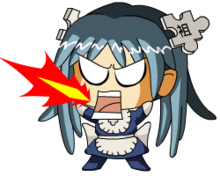Chibi (slang)
This article needs additional citations for verification. (April 2021) |

Chibi (ちび or チビ) is a Japanese slang word describing something short (an inanimate object, a human or other animal). The term is widely used to describe a specific style of caricature where characters are drawn in an exaggerated way: small and chubby, with stubby limbs and oversized heads. This style of artwork, also known as super deformed (shorthanded as SD), has since found its way into anime and manga fandom through its usage in manga works.
Etymology[]
Chibi is derived from the verb 禿びる (chibiru), which means 'to wear out and become shorter' (the tip of something). Chibi-debu (ちびデブ or チビデブ) is used to describe something or someone that is both short and chubby. Chibi can be translated as 'little' (e.g. Chibi Maruko-chan, which means Little Miss Maruko), but it is not used the same way as chiisana [小さな] and chiisai [小さい] ('tiny', 'small', 'little' in Japanese), but rather 'cute'.[1]
Proportions[]

The head of a chibi character is normally anywhere between one third and one half the character's height.[2] In addition to their modified proportions, chibi characters typically lack the details of their normal counterparts.[3] As a result, when a character of average proportions is depicted as a chibi character, certain aspects of their design will be simplified and others will be exaggerated. Details such as folds on a jacket are ignored, and general shapes are favored. If a character has a signature characteristic (odd hair, a particular accessory, etc.) this will typically be prominent on the chibi version of the character.[4] For example, chibified Sailor Moon characters’ hairstyles and outfits are enlargened and have detail, while the character's faces are more basic and the eyes are expressive and large.
Chibi characters are also known for their small bodies and large eyes and faces. While most anime characters have large eyes, chibi characters exaggerate the eye size and head size more than the other attributes; most chibi-style character figurines have bases under the feet because their head proportions are usually too big and would weigh down their bodies.[5] Chibi characters usually lack feet, and their shoes are heel-shaped, less-detailed versions of the shoes on the tip of their point-like feet. In some anime, characters from newborn age to age ten are drawn in a more chibi nature (until they surpass age 10, in which they look normal) with large heads, sparkly eyes, and less detail than their older character counterparts. An example of this is the titular Yotsuba Koiwai from Yotsuba&!.
Media usage[]
One example of chibi's usage in Japanese, which brought the term to the attention of Western fans, is Chibiusa; this diminutive pet name for the daughter of Sailor Moon comes from Chibi Usagi ('Little Rabbit').[6] The chibi art style is part of Japanese culture, and is seen everywhere from advertising and subway signs to anime and manga. [7] The style was popularized by franchises like Dragon Ball and SD Gundam in the 1980s. It is used as comic relief in anime and manga, giving additional emphasis to a character's emotional reaction.
The art style has also appeared in anime-influenced American series such as Homestuck, Teen Titans, and Avatar: The Last Airbender, which feature chibi-like characters in short episodes.[8] In some short episodes from Big Hero 6: The Series, the characters are rendered in a chibi style.
Chibi characters themselves appear usually as plushies, keychains, and other merchandise products of the characters in a certain anime. Keychains from the manga Magical Girl Site by Kentaro Sato feature Chibi versions of the characters. Chibi characters are often featured in video games as well as sprites. Take for instance, the Animal Crossing series, Clash of Clans,[9] Little Nightmares I and II, Stardew Valley, Story of Seasons and many of the early Pokémon games.
On the back of each tankōbon volume of Sailor Moon, chibi versions of each character is shown using their power in a “chibified” way, for example, Sailor Mars’ Fire is much smaller and less detailed. This “chibifiying” of magical powers is also seen in My Hero Academia chibis, Avatar chibis, and more.
See also[]
| Wikimedia Commons has media related to Chibi characters. |
- Kawaii, 'cute'
- Moe (slang), expression of fascination or infatuation
References[]
- ^ https://www.tofugu.com/japanese/chibi/
- ^ "A Super Deformed Tutorial". www.polykarbon.com. Archived from the original on 21 August 2008. Retrieved 3 December 2019.
- ^ https://www.hxchector.com/what-is-chibi/
- ^ How to Draw Manga Volume 18: Super-Deformed Characters 1: Humans. ISBN 9784766114355
- ^ https://honeysanime.com/what-is-chibi-definition-meaning/
- ^ "Sailor Moon volume 3 translation". Retrieved 23 May 2008.
- ^ https://evma.net/chibi-mascots-japan/
- ^ "Applying 2D Japanese Super-Deformed character to traditional American animation" (PDF). Retrieved 5 July 2018.
- ^ https://supercell.com/en/games/clashofclans/
- Anime and manga terminology
- Caricature
- Japanese culture
- Japanese popular culture
- Japanese words and phrases